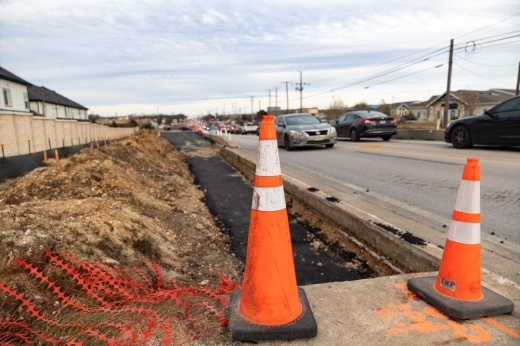With the city’s execution of its transportation master plan—a document guiding the future of road projects in the city of Round Rock—city staff said a few more crops of traffic cones will be popping up along major thoroughfares through 2029.
As of mid-January, over $121.9 million in road projects are under construction. The city also has another $171.8 million in projects in the design phase, which city staff say will be constructed over the next five years.
The big picture
The 13 road projects set to be completed over the next five years make up a collection of extensions, connections between existing roads and widenings to allow for increased traffic capacity, said Michael Thane, director of public works.
He said the timing of these projects comes in anticipation of growth in the city’s northeast and addressing constraints in the southeast.
Another factor is the availability of funding secured by city officials, said Gerald Pohlmeyer, the city’s capital improvement program manager.
“The council that we have now has put a high priority on getting funding to build out a number of these arterials,” he said. “We knew development was going to continue to come. As long as we can build out these arterials, it should keep our level of service close to where it is now.”
The $293 million in road projects for the city’s east side are part of a larger $1.9 billion transportation master plan, which was updated in 2023.
A closer look
Creating additional capacity along constrained roadways is one issue the city is taking head-on, as right-of-way-constrained streets like Gattis School Road and Red Bud Lane enter different stages in the widening process.
A constrained roadway means there is limited room on either side to widen it, and some designs must be reconfigured.
One of the ways this will be done, Pohlmeyer said, is by removing the center turn lanes from sections of the road, such as on Gattis School Road.
Gattis School Road and Red Bud Lane will be constructed out to six and four lanes, respectively.
Projects underway are what Pohlmeyer said are “ultimate sections,” or as wide as they will be able to be built. He said they will accommodate the city’s projected build-out of 270,000-330,000 residents.
How it works
The city can fund road work in a variety of ways, with some requiring the approval of voters in its taxing district. Others can be program-based, such as federal and state grants.
Road work can also be financed through certificates of obligation bonds, which don’t require voter approval; roadway impact fees; and sales taxes.
Once funding is secured, then the project can either be designed or go out for bid, Thane said.
As long as the various stages of construction go according to plan, he said road projects will generally be completed within the established timeline.
However, delays in acquiring materials or completing utility relocations can hold a project back.
One example is Gattis School Road Segment 6, which spans from Via Sonoma Trail to Red Bud Lane and is planned to expand from four to six lanes. The project was planned to start construction in 2022 but has faced delays in relocation of dry utilities, such as electricity and telecommunications, from Oncor and AT&T, Pohlmeyer said.
“The problem we have with the utilities is they will give us their completion dates, and then they don’t hit them,” he said.
In a statement to Community Impact, Sarah Rodriguez, AT&T’s lead public relations manager, wrote that a portion of utility relocations could not be completed until new power poles were placed.
She wrote that the telecommunications provider does not feel it is the cause of delays.
Armando Perez, a spokesperson for Oncor Electric Delivery, said in a statement that the utility relocations for the sixth segment of Gattis School Road have been completed and that this portion of the project required detailed coordination to transfer services. This process required temporary disconnection of power, and the utility company worked to complete these relocations with minimal interruptions to services.
“We are now awaiting the relocation of telecommunication utility equipment before we can proceed with removing the original poles,” the statement from Perez reads.
What community members are saying
Lori Steele, a five-year Round Rock resident, said the traffic in the city is one of several factors causing her to consider moving out of Central Texas.
Her home is near the Gattis School Road and Red Bud Lane intersection, a high-traffic corridor.
“There’s no such thing as a peaceful venture to the grocery store,” Steele said.
Steele said the biggest adjustment to increased traffic is simply giving herself extra time to get around town.
She’s also seen some changes to businesses in the area, including a local coffee shop.
In 2024, Dazzle Coffee & Smoothies closed its Round Rock shop on Gattis School Road. At the time, owners Corey Wertenberger and Mike Scheschuk said they closed because the center turn lane on Gattis School Road was removed and a concrete median put in its place. Now, drivers can only access the site via a right-hand turn.
What to expect
Several of the projects began construction late last year and in January.
Others in design are expected to go out for bid in the coming months, Thane said.
Residents can find updates to traffic patterns and road closures on the city’s social media channels.
“It’s like with any project,” Thane said. “It’s tough when you’re in the middle of it, but when it’s over, everyone likes it.”





